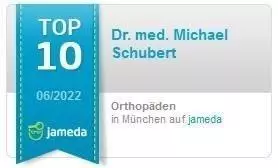Medical terms for non-physicians in the field of spinal surgery
Microscopic decompression
Microscopic decompression is a tissue-sparing form of spinal surgery that microscopically expands the spinal canal that is too narrow. This surgical technique makes it possible for us to discharge the patient who has undergone such an operation by our experienced and competent team after about 2-3 days. The patient thus has a short overall rehabilitation time and can quickly be integrated into his or her normal life.
The procedure of (microscopic) decompression describes a professionally performed procedure that is used, for example, in the case of spinal canal stenosis. Here, the excess tissue (bone and capsule tissue) is removed so that the pressure exerted on the nerves and spinal canal disappears.
herniated disc
Herniated disc is also commonly known as herniated disc. There are several intervertebral discs in the body. They are located between each vertebral body - except for the first and second. Thus, there are 23 intervertebral discs in total. The flexible intervertebral disc consists of an intervertebral disc core which is securely and firmly surrounded by a fibrous ring.
If this fibrous ring - anulus fibrosus - tears, a herniated or herniated disc occurs. As a result, the gelatinous core of the disc protrudes and causes severe back and/or leg pain. We treat your herniated disc in the cervical spine and/or lumbar spine professionally and gently with competent conservative therapy or - if the worst comes to the worst - with safe, minimally invasive endoscopic surgical therapy.
Endoscopic disc surgery
At the Apex Spine Center we work with the procedure of endoscopic disc surgery as part of our professional spine surgery. Unlike conventional procedures, we do not remove the patient's entire disc and replace it with an artificial one, we only remove the affected area of the herniated disc. In this way we ensure that the natural mobility and stability of the spine is retained.
This revolutionary disc surgery is performed almost exclusively by Dr. Schubert performed in the Apex Spine Center. A lateral entrance to the herniated disc is made through a small skin incision and a cannula and extremely fine tools are used.
Lumbar disc herniation
A lumbar disc herniation is a herniated disc in the lumbar spine (LWS). The intervertebral discs in the lumbar spine area are particularly thick. They act as shock absorbers that absorb vibrations. In the case of a herniated disc in the lumbar spine, the core of the affected disc protrudes from its protective ring, which is torn - for example due to high stress. As a result, acute back pain occurs. Furthermore, neurological failure damage can occur. Because the emerging intervertebral disc presses on the spinal nerves.
Degenerative lumbar scoliosis
Degenerative lumbar scoliosis refers to wear-related scoliosis in the lumbar spine area. Scoliosis is a lateral bending of the spine coupled with a rotation of the vertebral bodies. Over the years, the scoliosis angle usually gets worse and the symptoms increase. In most cases, a subtle, minimally invasive and tissue-sparing surgical technique is required to alleviate and eliminate these.
We recommend this gentle operation to our patients because - unlike conventional rough surgical procedures - it does not require long-term surgical stiffening from the patient. At the Apex Spine Center for spinal surgery, we use the procedure of microscopic decompression of the spinal canal, which protects the vertebral joints and in almost all cases completely eliminates the bony and ligamentous (= affecting the ligaments) stenosis or constriction, so that you can live free of back pain again .

